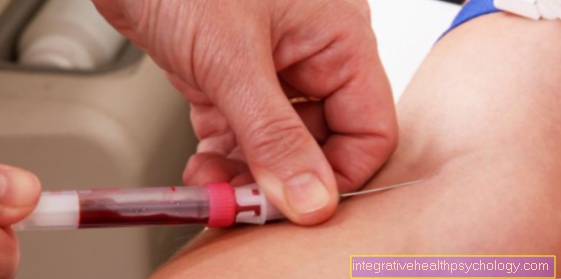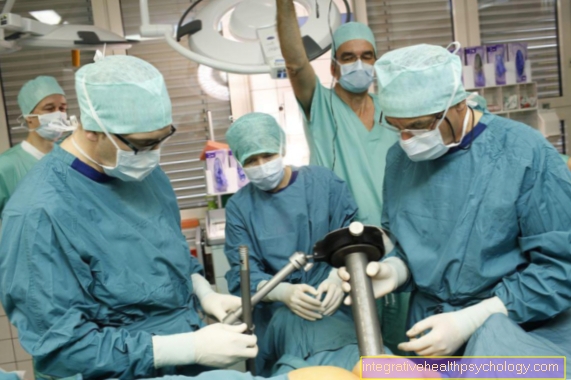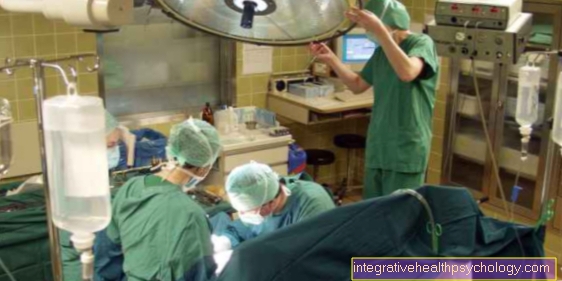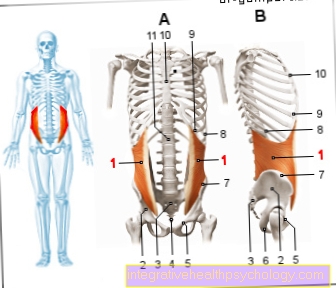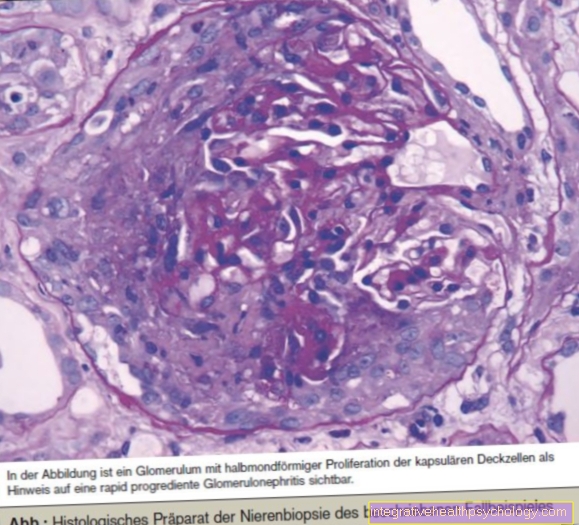Eye socket pain
introduction
Pain in the eye socket is a symptom that can occur in a wide variety of diseases.
It is a rather unspecific phenomenon and can have a wide variety of causes. Often structures outside the eye socket are also affected.
These are mostly harmless causes such as the flu, and dental problems can also cause pain in the eye socket.
There are also rare diseases, some of which can have serious consequences and require medical treatment.
In the following, the most common possible causes of pain in the eye socket based on various structures are examined.

Pain in the eye cavity from a flu or cold
A cold or the real flu manifests itself with a variety of symptoms. This can also lead to pain in the eye socket, which is usually caused by an inflammation of the paranasal sinuses.
Causes:
Of the Cause of pain is in the eye socket with the flu or cold in most cases a sinus infection.
If you suffer from the flu or a cold, the nasopharynx is particularly affected.
It is inflamed and filled with secretion in which there are many pathogens (mostly bacteria).
However, there are other air-filled sinuses in the facial skull, which are accessible via small passages connected to the nasal cavity are, namely four different caveslocated in the forehead (frontal sinus), jaw (maxillary sinus) and sphenoid bone.
In some cases it can be part of a flu or cold to one Spread of pathogens into the sinuses come, so that an inflammation of the sinuses (sinusitis) develops here.
Children are particularly affected when they have a cold or flu.
Through the immediate anatomical proximity in the eye socket there is also pain here.
In rare cases, the inflammation spreads directly to adjacent bone layers or the eye socket, making symptoms worse.
Usually there is pain in the eye socket even without inflamed sinuses, by the pressure (Intraocular pressure) in these due to difficult drainage of secretions elevated is. This also irritates nerves in the eye socket.
Symptoms:
In addition to the pain in the eye socket that occurs during a flu or cold, there are other symptoms that suggest a sinus infection. So let yourself watery eyes and slight redness observe.
Headaches are also common. The pain itself is oppressive and gain weight when leaning forward, e.g. when tying shoes.
The pain will be worse with eye movements. Also an easy one Knocking in the area of the forehead and above the eye socket causes an unpleasant pain.
Diagnosis:
Diagnosing a Sinusitis in the context of a cold or flu is primarily done by asking about the typical symptoms (as part of the anamnesis).
It is also possible to take a smear of nasal secretion if you want to identify a pathogen.
If there are complications such as inflammation of the eye socket, imaging such as an MRI, CT or X-ray can be useful.
Therapy:
The therapy for pain in the eye socket, which is caused by sinusitis with flu or cold, is mainly symptomatic.
The eye pain will go away as the disease subsides.
Decongestant nasal sprays and liquefying measures such as steam inhalation are used to help against sinusitis or congestion of the paranasal sinuses.
Pain relievers such as ibuprofen or paracetamol relieve the symptoms.
Herbal remedies such as Sinupret® forte or Sinupret® drops promote recovery.
In severe cases, inflammation must be fought with antibiotics, especially if the pain in the eye socket increases and does not go away after a few days.
Chronic complaints can make surgery necessary.
Nasal bone / bridge of the nose
Another cause of pain in the eye socket is found in the nasal bone or in the Root of the nose.
It is the so-called Nasociliary neuralgia.
Causes:
A neuralgia is a form of nerve pain in which already with simple touches or even in complete calm Pain arises.
In this case it is Nasociliary nerve affected.
There is one Hypersensitivity in the coverage area the nerve that extends from the tip of the nose over the root of the nose to the inner corner of the eye.
Neuralgia is caused by Inflammatory processes in the nerve, Metabolic diseases such as diabetes or rare diseases that directly cause nerve damage.
Also one decreased blood flow in the area of the nasal bone or the bridge of the nose can lead to a Damage to the nerve to lead.
Symptoms:
The main symptom of this disease is pain in the nasal bone or the root of the nose.
These usually have a stinging or burning character.
Mostly the pain one-sided localized on the side of the nose, pulling into the corner of the eye and the eye socket.
The pain in the eye socket can be out of complete rest occur or through touch in the supply area of the nerve and usually last a few seconds.
In some cases, pain at the root of the nose or nasal bone can still be felt after hours.
In addition, symptoms such as Swelling and Lacrimation occur.
Diagnosis:
In many cases, the diagnosis is not easy and tedious because the symptoms are rather unspecific.
A exact questioning (Anamnesis) of the patient brings the most of the findings.
After excluding all other causes such as special headaches or other forms of neuralgia, the Nasociliary neuralgia determine the cause.
Therapy:
One acute attack you can with local anesthetic agents that are applied to the surface of the nose or bridge of the nose or injected into the skin.
Medicinal products are similar to those used against cluster headaches and migraines, so-called Triptans or Ergotamines.
In addition, the affected nerve blocked and be severed as a last resort.
tooth
In some cases you can Problems in the dental area Cause pain in the eye socket.
Inflammation or injuries to nerves, for example, sometimes radiate into the eye socket.
Causes:
A common cause for pain in the eye socket that occurs on the tooth is a tooth root inflammation.
In contrast to caries, the root with which the tooth is anchored in the jaw is also affected.
There are also many nerve fibers in this area, which, bundled as a nerve, go to the brain via switching stations.
These nerves are caused by inflammation in the tooth irritated, the pain can be caused by the special course of the nerves radiate into the eye socket.
A other causethat causes pain in the eye socket starting from the tooth is the so-called dentogenic maxillary sinusitis (dentogenic: lat. for "starting from the teeth"; maxillary sinusitis: lat. for inflammation of the maxillary sinus).
This is an inflammation of the paranasal sinuses in the area of the upper jaw, which is not caused by a cold or flu.
Rather, it comes to a expansion a tooth root inflammation in the upper jaw on the neighboring Sinus.
This is anatomically in very close relationship to the teeth.
In addition to inflammation in the tooth, which gets worse over time and invades the maxillary sinus, after a tooth has been extracted, also germs from the oral cavity penetrate the wound and cause inflammation.
Is the Inflamed maxillary sinus, it comes through that Neighborhood to the eye socket there to pain.
In the worst case, an abscess will develop over time, making the pain worse.
Symptoms:
The symptoms of a dentogenic Sinusitis are pressure, pain in the cheek area and eye socket and possibly swelling or redness.
In the case of an abscess, the pain will get worse. These complaints occur a few hours to a few days after a tooth extraction, or in the course of an untreated root inflammation.
If you have problems with the tooth and notice pain in the eye socket or if this occurs after an operation in the mouth area, you should consult a doctor immediately.
Diagnosis:
At the beginning of the diagnosis there is a detailed anamnesis of the complaints, together with the question of previous complaints to the tooth.
A knocking pain over the maxillary sinus gives further clues to the Maxillary sinusitis. An accurate diagnosis is made with an MRI or CT scan. A blood test for signs of inflammation can also help, and a nasoscopy may be performed.
The eye socket should also be examined by an ophthalmologist to assess the involvement of the eye.
Therapy:
Eliminating the cause is the first and most effective step in treating eye socket pain that originates from the tooth. Against the Sinusitis Decongestant nose drops and the inhalation of hot steam help, in severe cases antibiotics are used.
If a purulent abscess develops, a surgical procedure is performed to remove it.
Ibuprofen can be given to relieve pain and inflammation.
Temple / forehead
Pain in the eye socket can also be related to processes in the forehead or temple area.
There is inflammation of the sinus in the forehead (Frontal sinus) in the foreground, headaches can also cause pain in the eye socket, temple and forehead.
Read more on the topic: Headache forehead
Causes:
The most likely cause of pain in the temple, forehead, and eye socket is sinus infection caused by a cold. In this case, the frontal sinus, which is located behind the forehead, is affected.
A swollen nose disturbs the outflow of secretion and can lead to blockage of the connecting ducts to the paranasal sinuses, which are connected to the nasal cavity.
Inflammation then occurs in some cases. Different forms of headache can also cause pain in all of these areas.
Read more on this topic at: Headache with a cold
Symptoms:
A sinus infection of the frontal sinus causes pain in the forehead area, which can spread to the eye socket and temples.
In addition, there are typical cold symptoms such as nasal congestion, headache and fatigue, possibly with a fever.
Pressure on the forehead makes the pain worse, and a throbbing throbbing is often noticed in the temple.
Diagnosis:
The diagnosis of inflammation of the frontal sinus is primarily a clinical one, i.e. one asks the patient's complaints and symptoms in the course of the anamnesis.
In cases of doubt, imaging by means of X-rays, CT or MRI can provide information.
In many cases, an accurate diagnosis of headache is not necessary.
In severe cases, however, this may be necessary and should be done by specialists. A detailed survey is indicative here and can be expanded through special tests.
Therapy:
A Sinusitis (Sinusitis) is treated conservatively with painkillers and supportive measures such as nasal drops and steam inhalation.
Usually this is healed after a few days.
Therapy for headache causing pain in the eye socket is also symptomatic. Only if there is an organic cause is targeted treatment, such as migraines, against which triptans are used.
Read more on the topic: Pain temple
forecast
In most cases, pain in the eye socket is harmless and only a side symptom of another of the above mentioned illnesses.
Will the root cause treated, the pain in the eye socket will also disappear.
Only in rare cases like an abscess in the jaw or one that extends to the eye Sinusitis the greatest caution is advised, as in the worst case the eye can be damaged. However, this only happens if one does not seek treatment. The course of nasociliary neuralgia can take longer.
prophylaxis
It's tough, targeted the pain in the eye to prevent.
To a To avoid sinusitis it is best to contact first signs of a cold to strain less and to take nasal drops against the swelling of the nasal mucosa.
Headaches and neuralgia come with stress and one unhealthy lifestyle associated, so that there are starting points for prophylaxis against pain in the eye socket.
After a visit to the dentist one should pay close attention to any changes such as pain so that they can be treated quickly and specifically to prevent worse complications.





